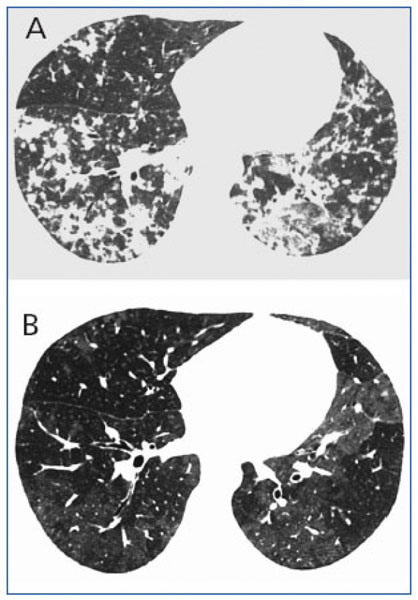Mi SciELO
Servicios Personalizados
Revista
Articulo
Indicadores
-
 Citado por SciELO
Citado por SciELO -
 Accesos
Accesos
Links relacionados
-
 Citado por Google
Citado por Google -
 Similares en
SciELO
Similares en
SciELO -
 Similares en Google
Similares en Google
Compartir
Nefrología (Madrid)
versión On-line ISSN 1989-2284versión impresa ISSN 0211-6995
Nefrología (Madr.) vol.30 no.2 Cantabria 2010
Pulmonary toxicity associated with sirolimus following kidney transplantation: computed tomography findings
Dear Editor:
We read with great interest the letter by Calle et al.1 describing the case of a patient who underwent a kidney transplant and developed a pneumonitis caused by sirolimus. They related that there are, until now, only seven cases reported of recovery from pneumonitis caused by sirolimus.
We would like to describe the case of a 27-year-old woman with a two-year history of haemodialysis for endstage renal disease underwent a haplo-identical, living kidney, donor transplantation. Following the procedure, she began immunosuppressive therapy with tacrolymus, mycophenolate mofetil, and steroid. Her renal function was stable and she was discharged with normal serum creatinine levels.
Two months after beginning immunosuppressive therapy she presented with diarrhoea of unknown aetiology. After recovery from the diarrhea, the patient was discharged while using mycophenolate sodium and metronidasol. Six months later, she was admitted with another episode of diarrhea and the tacrolymus was switched to sirolimus.
Ten months after initiation of the sirolimus treatment, the patient was admitted with fever, shortness of breath, and dehydration. Chest X-rays and high-resolution CT of the chest demonstrated bilateral areas of nonhomogeneous air space consolidation, mainly in the left upper lobe and lower lobes (figure 1A). Bronchoalveolar lavage revealed hypercellularity with lymphocytosis, and the microbiological evaluation was negative for bacteria, fungi, and viruses. Serological tests for cytomegalovirus were negative. The patient began an empirical, antiinfection treatment with intravenous azithromycin and ciprofloxacin, with no response. The fever persisted with antibiotic treatment and sirolimus was thought to be the cause of the symptoms. When sirolimus was switched to azathioprime symptoms improved within 10 days, and were resolved in 30 days. On the follow-up chest X-ray and high-resolution CT, 30 days after sirolimus discontinuation, the parenchymal abnormalities had improved, with accentuated reduction of the air-space consolidation pattern. There were persisting residual areas of bilateral ground-glass opacities on the high-resolution CT (figure 1B).

Figure 1. High-resolution CT at the level of the lower lobes (A)
(obtained at the time of clinical presentation when respiratory symptoms were evident)
demonstrates areas of non-homogeneous air space consolidation in the lower lobes,
and mild ground-glass opacities. Followup scan (B), taken in the same plain as A,
and 30 days after discontinuation of sirolimus, showed a reduction in the airspace
consolidation pattern, with bilateral areas of residual ground-glass attenuation.
The expiratory scans did not show air trapping.
Sirolimus (rapamycin) is a potent immunosuppressive drug that has been successfully used in solid organ transplant recipients as an alternative to calcineurin inhibitor therapy2-4. The most common side effects associated with this drug are dose-dependent hyperlipidemia, and thrombocytopenia. Unlike calcineurin inhibitors, sirolimus does not induce acute or chronic nephrotoxicity. However, in very rare cases, patients treated with sirolimus may exhibit severe pulmonary toxicity2,3.
The symptoms of pulmonary toxicity related to sirolimus are generally nonspecific, and may include a dry cough, dyspnea, fatigue, and fever, frequently leading to the initial diagnosis of pulmonary infection5. Some reports have described histopathological patterns as a result of sirolimus pulmonary toxicity, but these findings are usually nonspecific, consisting of bronchiolitis obliterans with organizing pneumonia, interstitial pneumonitis, and nonnecrotizing granulomas2,4. For this reason, a lung biopsy is not essential, and the diagnosis of this condition must fulfil the following criteria: presence of lung disease on imaging tests, exclusion of pulmonary infection or other lung disease, and clinical improvement after drug withdrawal, independent of the pulmonary biopsy4,5. All these criteria were fulfilled in the patient presented here, who showed significant imaging and clinical improvement after withdrawal of sirolimus.
Due to the increased use of sirolimus, radiologists interpreting imaging studies of transplant patients using this drug should be aware of the imaging features associated with this potentially treatable complication. Although some previous authors reported the use of CT2,3,5, to our knowledge, there are no reports illustrating and discussing the highresolution CT findings of pulmonary toxicity due to sirolimus.
T. Davaus Gasparetto1,2, Edson Marchiori1,, P. Menezes3, G. Zanetti2
1Department of Radiology. Fluminence Federal University. Rio de Janeiro Federal University. Niterói, Rio de Janeiro (Brazil)
2Department of Radiology. Federal University. Rio de Janeiro (Brazil)
3Department of Nephrology. Fluminence Federal University. Niterói, Rio de Janeiro (Brazil)
References
1. Calle L, Tejada C, Lancho C, Mazuecos A. Pneumonitis caused by sirolimus: improvement after switching to everolimus. Nefrologia 2009;29(5):490-1. [ Links ]
2. Adibelli Z, Dilek M, Kocak B, Tulek N, Uzun O, Akpolat T. An unusual presentation of sirolimus associated cough in a renal transplant recipient. Transplant Proc 2007;39(10):3463-4. [ Links ]
3. Champion L, Stern M, Israel-Biet D, et al. Brief communication: sirolimus-associated pneumonitis: 24 cases in renal transplant recipients. Ann Intern Med 2006;144(7):505-9. [ Links ]
4. Chhajed PN, Dickenmann M, Bubendorf L, Mayr M, Steiger J, Tamm M. Patterns of pulmonary complications associated with sirolimus. Respiration 2006;73(3):367-74. [ Links ]
5. Haydar AA, Denton M, West A, Rees J, Goldsmith DJ. Sirolimus-induced pneumonitis: three cases and a review of the literature. Am J Transplant 2004;4(1):137-9. [ Links ]
![]() Correspondence:
Correspondence:
Edson Marchiori,
Rua Thomaz Cameron, 438. Valparaiso.,
CEP 25685., Niterói, Rio de Janeiro, Brazil
E-mail: edmarchiori@gmail.com














